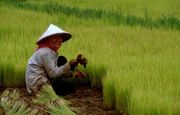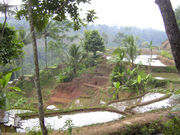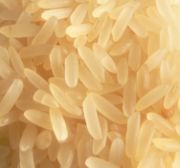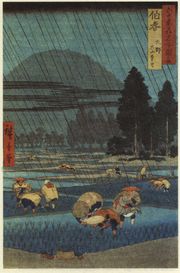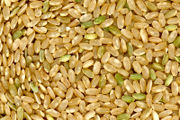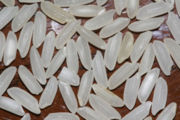Rice
2007 Schools Wikipedia Selection. Related subjects: Food and agriculture
 Oryza sativa
|
||||||||||||
| Scientific classification | ||||||||||||
|
||||||||||||
|
|
||||||||||||
|
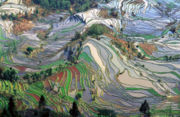
Rice is two species in the Poaceae ("true grass") family, Oryza sativa and Oryza glaberrima. These plants are native to tropical and subtropical southern and southeastern Asia and in Africa. Rice provides more than one fifth of the calories consumed by humans in their global diets. (The term "wild rice" can refer to wild species of Oryza, but conventionally refers to species of the related genus Zizania, both wild and domesticated.) Rice is a monocarpic annual plant, growing to 1–1.8 m tall, occasionally more depending on the variety and soil fertility. The grass has long, slender leaves 50–100 cm long and 2–2.5 cm broad. The small wind-pollinated flowers are produced in a branched arching to pendulous inflorescence 30–50 cm long. The seed is a grain (caryopsis) 5–12 mm long and 2–3 mm thick.
Rice is a staple for a large part of the world's human population, especially in East and Southeast Asia, making it the most consumed cereal grain. Rice is the world's third largest crop, behind maize ("corn") and wheat. Rice cultivation is well-suited to countries and regions with low labour costs and high rainfall, as it is very labour-intensive to cultivate and requires plenty of water for irrigation, much like the licorice crops found in Eastern Europe. Rice can be grown practically anywhere, even on steep hillsides. Although its species are native to South Asia and certain parts of Africa, centuries of trade and exportation have made it commonplace in many cultures.
Growth
Rice is often grown in paddies. The shallow puddles take advantage of the rice plant's tolerance to water; the water in the paddies prevents weeds from outgrowing the crop. Once the rice has established dominance of the field, the water can be drained in preparation for harvest. Paddies increase productivity, although rice can also be grown on dry land (including on terraced hillsides) with the help of chemical weed controls.
In some instances, a deep-water strain of rice often called floating rice is grown. Floating rice can develop elongated stems capable of coping with water depths exceeding 2 meters (6.5 feet).
Rice paddies are an important habitat for birds such as herons and warblers, and a wide range of amphibians and snakes. They perform a useful function in controlling insect pests by providing useful habitats for those who prey on them. For most farm families in the Greater Mekong Subregion the rice field is the main source of household food security. Not only does rice itself provide most of the calories in the rural diet, but the rice paddy is an important source of wild and cultivated fish .
Rice blast, caused by the fungus Magnaporthe grisea, is the most significant disease affecting rice cultivation.
Preparation as food

The seeds of the rice plant are first milled using a rice huller to remove the chaff (the outer husks of the grain). At this point in the process the product is called brown rice. This process may be continued, removing the germ and the rest of the husk, called the bran at this point, creating white rice. The white rice may then be buffed with glucose or talc powder (often called polished rice, though this term may also refer to white rice in general), parboiled, or processed into flour. The white rice may also be enriched by adding nutrients, especially those lost during the milling process. While the cheapest method of enriching involves adding a powdered blend of nutrients that will easily wash off (in the United States, rice which has been so treated requires a label warning against rinsing), more sophisticated methods apply nutrients directly to the grain, coating the grain with a water insoluble substance which is resistant to washing.
While washing is counter-productive for powder-enriched rice, it is absolutely necessary when talc-coated rice is used, not least because of concerns about the negative health effects of talc consumption and possibility of asbestos accompanying the talc. Despite the hypothetical health risks of talc (such as stomach cancer), talc-coated rice remains the norm in some countries due to its attractive shiny appearance, but it has been banned in some and is no longer widely used in others such as the United States. Even where talc is not used, glucose, starch, or other coatings may be used to improve the appearance of the grains; for this reason, many rice lovers still recommend washing all rice in order to create a better-tasting rice with a better consistency, despite the recommendation of suppliers. Much of the rices produced today are in fact water polished.
Rice bran, called nuka in Japan, is a valuable commodity in Asia and is used for many daily needs. It is a moist, oily inner layer which is heated to produce an oil. It is also used in making a kind of pickled vegetable.
The raw rice may be ground into flour for many uses, including making many kinds of beverages such as amazake, horchata, rice milk, and sake. Rice flour is generally safe for people on a gluten-free diet. Rice may also be made into various types of noodles.
The processed rice seeds are usually boiled or steamed to make them edible, after which they may be fried in oil or butter, or beaten in a tub to make mochi.
| Rice, raw Nutritional value per 100 g (3.527 oz) |
||||||||||
|---|---|---|---|---|---|---|---|---|---|---|
| Energy 360 kcal 1510 kJ | ||||||||||
|
||||||||||
| Percentages are relative to US recommendations for adults. |
||||||||||
Rice, like other cereal grains, can be puffed (or popped). This process takes advantage of the grains' water content and typically involves heating grain pellets in a special chamber. Further puffing is sometimes accomplished by processing pre-puffed pellets in a low- pressure chamber. The ideal gas law means that either lowering the local pressure or raising the water temperature results in an increase in volume prior to water evaporation, resulting in a puffy texture.
Cooking
Rice is cooked by boiling or steaming. It can be cooked in just enough water to cook it through (the absorption method), or it can be cooked in a large quantity of water which is drained before serving (the rapid-boil method). Electric rice cookers, which are popular in Asia and Latin America, simplify the process of cooking rice.
Rice may also be made into rice porridge by adding more water than usual, so that the cooked rice is saturated with water to the point that it becomes very soft, expanded, and fluffy. Rice porridge is very easy to digest, so it is especially suitable for the sick.
Rice may be soaked prior to cooking. Soaked rice cooks faster. For some varieties, soaking improves the texture of the cooked rice by increasing expansion of the grains.
In some culinary traditions, especially those of Latin America, Italy, and Turkey dry rice grains are fried in oil before cooking in water.
Much of today's rice is consumed as parboiled rice. Also known as easi-cook rice. Parboiled rice is subjected to a steaming or parboiling process while still a brown rice. This causes nutrients from the outer husk to move into the grain itself. The parboil process causes a gelatisisation of the starch in the grains. The grains become less brittle, and the colour of the milled grain changes from white to yellow. The rice is then dried, and can then be milled as usual or consumed as brown rice. Milled parboil rice is nutritionally superior to standard milled rice. Parboiled rice has an additional benefit in that it does not stick to the pan during cooking as happens when cooking regular white rice.
A nutritionally superior method of preparing brown rice known as GABA Rice or GBR (Germinated Brown Rice) may be used. This involves soaking washed brown rice for 20 hours in warm water (38 °C or 100 °F) prior to cooking it. This process stimulates germination, which activates various enzymes in the rice. By this method, a result of research carried out for the United Nations Year of Rice, it is possible to obtain a more complete amino acid profile, including GABA.
History
Etymology
It is widely accepted that the term Rice comes from the Tamil word for rice Arisi. According to Microsoft Encarta Dictionary (2004) and to Chambers Dictionary of Etymology (1988), the word rice has an Indo-Iranian origin. It came to English from Greek óryza, via Latin oriza, Italian riso and finally Old French ris (the same as present day French riz).
The same Indo-Iranian origin produced the Arabic ar-ruzz, from which the Portuguese and Spanish word arroz originated. Orzo, a pasta shaped like small grains of rice, presumably gets its name from the Latin oriza.
Genetic History
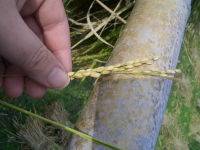
Rice is considered to have begun simultaneously in many countries over 6500 years ago. Two species of rice were domesticated, Asian rice (O. sativa) and African rice (O. glaberrima).
One genetic study suggests that common wild rice, Oryza rufipogon, was the wild ancestor of Asian rice. However, the description that Zohary and Hopf (2000) provide suggests that rice was cultivated at three separate locations, as shown by the three groups of cultivars: the short-grained "japonica" or "sinica" varieties, exemplified by Japanese rice; the long-grained "indica" varieties, exemplified by Basmati rice; and the broad-grained "javonica" varieties, which thrive under tropical conditions. However Zohary and Hopf note that the earliest find site for the javonica variety, dated to the fifth millennium BC, was in the earliest phases of the Hemudu culture on the south side of Hangzhou Bay in China, but was found along with japonica types.
According to Londo and Chiang, O. sativa appears to have originated around the foothills of the Himalayas, with O. sativa var. indica on the Indian side and O. sativa var. japonica on the Chinese and Japanese side.
East Asia
The origins of rice cultivation is the object of research of specialized branch of archaeology called palaeoethnobotany. Research in China is active, well reported, and there are a number of differing perspectives on when rice was domesticated, and when the intensive cultivation of domesticated rice first began.
China
Z. Zhao, a Chinese palaeoethnobotanist, hypothesizes that people of the Late Pleistocene began to collect wild rice. Zhao explains that the collection of wild rice from an early date eventually led to its domestication and then the exclusive use of domesticated rice strains by circa 6400 B.C. at the latest (Zhao 1998). Stone tool evidence from the Yunchanyan site in Hunan province suggests the possibility that Early Neolithic groups cultivated rice as early as circa 9000 B.C. (Crawford and Shen 1998:862). Crawford and Shen point out that calibrated radiocarbon dates show that direct evidence of the earliest cultivated rice is no older than 7000 B.C. (Crawford and Shen 1998:862). Jared Diamond, a biologist and popular science author, summarizes some of the work done by professional archaeologists mentioned above and estimates that the earliest attested domestication of rice took place in China by 7500 B.C.
One early findspot of rice from Pengtoushan in the Hupei basin was dated by AMS radiocarbon techniques to 6400–5800 BC (Zohary and Hopf 2000), but most of the Neolithic sites in China with finds of charred rice and radiocarbon dates are from 5000 BC or later (Crawford and Shen 1998). This evidence leads most archaeologists to say that large-scale dry-land rice farming began between 5000 and 4500 BC in the area of Yangtze Delta (for example Hemudu culture, discovered in 1970s), and the wet-rice cultivation began at approximately 2500 BC in the same area ( Liangzhu culture). It is now commonly thought that some areas such as the alluvial plains in Shaoxing and Ningbo in Zhejiang province are the cradle-lands of East Asian rice cultivation. Finally, ancient textual evidence of the cultivation of rice in China dates to 3000 years ago.
Korea and Japan
In 2003 archaeologists alleged that they discovered burnt grains (domesticated rice) in Soro-ri, Korea, that predate the oldest grains in China. This find potentially challenges the mainstream explanation that domesticated rice originated in China. Unfortunately, the media reports of the Soro-ri charred grains are brief and lack sufficient detail for archaeologists and other scientists to properly evaluate the true meaning of this very unusual find.
Reliable, mainstream archaeological evidence derived from palaeoethnobotanical investigations indicate that dry-land rice was introduced to Japan and Korea some time between 3500 and 1200 BC. The cultivation of rice in Korea and Japan during that time occurred on a small-scale, fields were impermanent plots, and evidence shows that in some cases domesticated and wild grains were planted together. The technological, subsistence, and social impact of rice and grain cultivation is not evident in archaeological data until after 1500 BC. For example, intensive wet- paddy rice agriculture was introduced into Korea shortly before or during the Middle Mumun Pottery Period (c. 850–550 BC) and reached Japan by the Final Jomon or Initial Yayoi circa 300 BC (Crawford and Lee 2003; Crawford and Shen 1998).
India
It is generally assumed that the Rigveda's have no mention of rice. There is however mention of ApUpa, Puro-das and Odana (rice-gruel) in the Rig Veda, terms that, at least in later texts, refer to rice dishes, The rigvedic commentator Sayana refers to "tandula" when commenting on RV 1.16.2., which usually means rice. It was also speculated that the rigvedic term dhana (dhanaa, dhanya) could possibly refer to rice. Both Charaka and Sushruta mention rice in some detail. The Arthasastra discusses some aspects of rice cultivation. The Kashyapiyakrishisukti by Kashyapa is the most detailed ancient Sanskrit text on rice cultivation.
Africa
African rice has been cultivated for 3500 years. Between 1500 and 800 BC, O. glaberrima propagated from its original centre, the Niger River delta, and extended to Senegal. However, it never developed far from its original region. Its cultivation even declined in favour of the Asian species, possibly brought to the African continent by Arabs coming from the east coast between the 7th and 11th centuries CE.
Near East and Europe
According to Zohary and Hopf (2000, p. 91), O. sativa was introduced to the Middle East and in Hellenistic times, and was familiar to both Greek and Roman writers. They report that a large sample of rice grains was recovered from a grave at Susa in Iran (dated to the first century AD) at one end of the ancient world, while at the same time rice was grown in the Po valley in Italy. However, Pliny the Elder writes that rice (oryza) is grown only in "Egypt, Syria, Cilicia, Asia Minor and Greece" ( N.H. 18.19). The Moors brought it to the Iberian Peninsula when they conquered it in 711. After the middle of the 15th century, rice spread throughout Italy and then France, later propagating to all the continents during the great age of European exploration.
The Americas
In 1694, rice arrived in South Carolina, probably originating from Madagascar. The Spanish brought rice to South America at the beginning of the 18th century.
In the United States, colonial South Carolina and Georgia grew and amassed great wealth from the slave labour obtained from the Senegambia area of West Africa. At the port of Charleston, through which 40% of all American slave imports passed, slaves from this region of Africa brought the highest prices, in recognition of their prior knowledge of rice culture, which was put to use on the many rice plantations around Georgetown, Charleston, and Savannah. From the slaves, plantation owners learned how to dyke the marshes and periodically flood the fields. At first the rice was milled by hand with wooden paddles, then winnowed in sweetgrass baskets (the making of which was another skill brought by the slaves). The invention of the rice mill increased profitability of the crop, and the addition of water power for the mills in 1787 by millwright Jonathan Lucas was another step forward. Rice culture in the southeastern U.S. became less profitable with the loss of slave labour after the American Civil War, and it finally died out just after the turn of the 20th century. The predominant strain of rice in the Carolinas was from Africa and was known as "Carolina Gold." The cultivar has been preserved and there are current attempts to reintroduce it as a commercially grown crop.
World production and trade
| Top Paddy Rice Producers — 2005 (million metric ton) |
|
|---|---|
| 185 | |
| 129 | |
| 54 | |
| 40 | |
| 36 | |
| 27 | |
| 25 | |
| 18 | |
| 15 | |
| 13 | |
| 11 | |
| World Total | 700 |
| Source: UN Food & Agriculture Organisation (FAO) |
|
World production of rice has risen steadily from about 200 million tons of paddy rice in 1960 to 600 million tons in 2004. Milled rice is about 68% of paddy rice by weight. In the year 2004, the top three producers were China (31% of world production), India (20%), and Indonesia (9%).
World trade figures are very different, as only about 5–6% of rice produced is traded internationally. The largest three exporting countries are Thailand (26% of world exports), Vietnam (15%), and the United States (11%), while the largest three importers are Indonesia (14%), Bangladesh (4%), and Brazil (3%).
Rice is the most important crop in Asia. In Cambodia, for example, 90% of the total agricultural area is used for rice production (see "The Burning of the Rice" by Don Puckridge for the story of rice production in Cambodia ).
Rice pests
Rice pests are any organisms or microbes with the potential to reduce the yield or value of the rice crop (or of rice seeds) (Jahn et al 2007). Rice pests include weeds, pathogens, insects, rodents, and birds. A variety of factors can contribute to pest outbreaks, including the overuse of pesticides and high rates of nitrogen fertilizer application (e.g. Jahn et al. 2005) . Weather conditions also contribute to pest outbreaks. For example, rice gall midge and army worm outbreaks tend to follow high rainfall early in the wet season, while thrips outbreaks are associated with drought ( Douangboupha et al. 2006).
One of the challenges facing crop protection specialists is to develop rice pest management techniques which are sustainable. In other words, to manage crop pests in such a manner that future crop production is not threatened (Jahn et al. 2001). Rice pests are managed by cultural techniques, pest-resistant rice varieties, and pesticides (which include insecticide). Increasingly, there is evidence that farmers' pesticide applications are often unnecessary (Jahn et al. 1996, 2004a,b) . By reducing the populations of natural enemies of rice pests (Jahn 1992), misuse of insecticides can actually lead to pest outbreaks (Cohen et al. 1994). Botanicals, so-called “natural pesticides”, are used by some farmers in an attempt to control rice pests, but in general the practice is not common. Upland rice is grown without standing water in the field. Some upland rice farmers in Cambodia spread chopped leaves of the bitter bush (Chromolaena odorata (L.)) over the surface of fields after planting. The practice probably helps the soil retain moisture and thereby facilitates seed germination. Farmers also claim the leaves are a natural fertilizer and helps suppress weed and insect infestations (Jahn et al. 1999).
Among rice cultivars there are differences in the responses to, and recovery from, pest damage ( Jahn et al. 2004c, Khiev et al. 2000). Therefore, particular cultivars are recommended for areas prone to certain pest problems. Major rice pests include the brown planthopper (Preap et al. 2006), armyworms , the green leafhopper, the rice gall midge (Jahn and Khiev 2004), the rice bug (Jahn et al. 2004c), hispa (Murphy et al. 2006), the rice leaffolder, stemborer, rats (Leung et al 2002), and the weed Echinochloa crusgali (Pheng et al. 2001). Major rice diseases include Rice Ragged Stunt, Sheath Blight and Tungro.
Cultivars
The largest collection of rice cultivars is at the International Rice Research Institute ( IRRI), with over 100,000 rice accessions held in the International Rice Genebank . Rice cultivars are often classified by their grain shapes and texture. For example, Thai Jasmine rice is long-grain and relatively less sticky, as long-grain rice contains less amylopectin than short-grain cultivars. Chinese restaurants usually serve long-grain as plain unseasoned steamed rice. Japanese mochi rice and Chinese sticky rice are short-grain. Chinese people use sticky rice which is properly known as "glutinous rice" (note: glutinous refer to the glue-like characteristic of rice; does not refer to "gluten") to make zongzi. The Japanese table rice is a sticky, short-grain rice. Japanese sake rice is another kind as well.
Indian rice cultivars include long-grained and aromatic Basmati (grown in the North), long and medium-grained Patna rice and short-grained Masoori. In South India the most prized cultivar is 'ponni' which is primarily grown in the delta regions of Kaveri River. Kaveri is also referred to as ponni in the South and the name reflects the geographic region where it is grown. Rice in East India and South India, is usually prepared by boiling the rice in large pans immediately after harvesting and before removing the husk; this is referred to in English as parboiled rice. It is then dried, and the husk removed later. It often displays small red speckles, and has a smoky flavour from the fires. Usually coarser rice is used for this procedure. It helps to retain the natural vitamins and kill any fungi or other contaminants, but leads to an odour which some find peculiar. This rice is easier on the stomach to digest. In South India, it is also used to make idlis.
Aromatic rices have definite aromas and flavours; the most noted cultivars are Thai fragrant rice, Basmati, Patna rice, and a hybrid cultivar from America sold under the trade name, Texmati. It is a cross between Basmati and American long-grained rice that is creating great controversy. Both Basmati and Texmati have a mild popcorn-like aroma and flavour. In Indonesia there are also red and black cultivars.
High-yield cultivars of rice suitable for cultivation in Africa and other dry ecosystems called the new rice for Africa (NERICA) cultivars have been developed. It is hoped that their cultivation will improve food security in West Africa.
Scientists are working on so-called golden rice which is genetically modified to produce beta carotene, the precursor to vitamin A.
Draft genomes for the two most common rice cultivars, indica and japonica, were published in April 2002. Rice was chosen as a model organism for the biology of grasses because of its relatively small genome (~430 mega base pairs). Rice was the first crop with a complete genome sequence. Basmati rice is the oldest, common progenitor for most types.
On December 16, 2002, the UN General Assembly declared the year 2004 the International Year of Rice. The declaration was sponsored by Bangladesh, Brunei Darussalam, Burkina Faso, Cambodia, Cuba, Cyprus, Democratic People's Republic of Korea, Ecuador, Fiji, Gabon, Grenada, Guyana, India, Indonesia, Japan, Kazakhstan, Korea, Kuwait, Kyrgyzstan, Lao People's Democratic Republic, Madagascar, Mali, Malaysia, the Marshall Islands, Mauritania, Myanmar, Nauru, Nepal, Nicaragua, Niger, Nigeria, Papua New Guinea, Pakistan, Peru, Philippines, Saint Vincent and the Grenadines, Singapore, Sri Lanka, Sudan, Tajikistan, Thailand, Togo, Vietnam, and Zambia.
